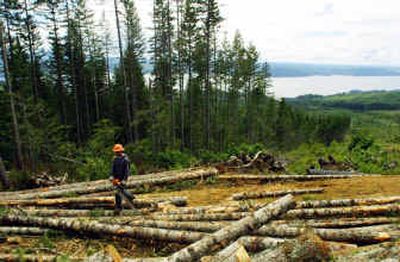State submits plan to protect forests

OLYMPIA – Washington state is asking the federal government to sign off on a 50-year conservation plan aimed at protecting 9.1 million acres of forest, as well as protecting logging companies from Endangered Species Act lawsuits.
The agreement would cover nearly a quarter of Washington’s total land area. It’s based on the state’s 1999 Forest and Fish Act, which limited logging near streams and steep hillsides to preserve threatened salmon runs.
“Our streams, our fisheries and our wildlife will get much better protection,” Gov. Christine Gregoire said Wednesday. “At the same time, an important sector of our economy can continue operating with some certainty.”
Timber company officials worked with the state on the 1999 Forest and Fish Act. Their industry was devastated by logging restrictions after the northern spotted owl was listed as threatened under the Endangered Species Act, and they wanted to avoid a similar fate when two dozen runs of Pacific salmon were listed as threatened or endangered in the late 1990s.
The agreement, called a Habitat Conservation Plan, would assure landowners and timber companies that they won’t get in trouble with the Endangered Species Act as long as they follow the Forest and Fish rules for logging.
Federal officials on Wednesday said they’re thrilled with Washington state’s proposal.
“This is a major commitment to protect habitat, and that’s something we want to reward because it’s key to recovery,” said Bob Lohn, regional administrator of the National Marine Fisheries Service.
Lohn said that while the agreement still has to go through the public comment and federal approval process, he’s optimistic about approval because the plan takes a preventive, proactive approach to protecting endangered and threatened species.
Environmentalists say the plan’s success depends on how flexible it is. Over 50 years, new problems could surface or new scientific discoveries could change the best practices for conservation.
For example, 40 years ago, forestry students were taught to “clean up” after logging operations by removing logs from streams, said Becky Kelly, campaign director for the Washington Environmental Council. Now timber companies pay people to put logs in streams to create better habitat for salmon.
“Maybe over time, science will say we need to put buffers on smaller streams,” Kelly said. “If the plan can be changed, it’s probably going to work pretty well.”
If it’s rigid, she said, “We’re not going to be serving the fish very well.”
State Public Lands Commissioner Doug Sutherland said the beauty of the plan is it’s based on “adaptive management” – meaning the rules can change when new information becomes available.
“This is not a static action,” Sutherland said. “Things do change, and we do have ways and procedures to recognize, change and improve the Habitat Conservation Plan.”